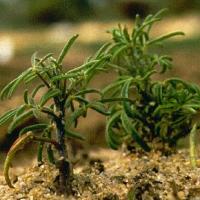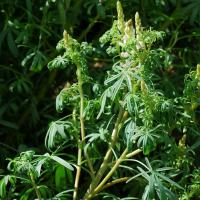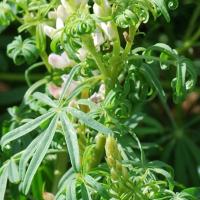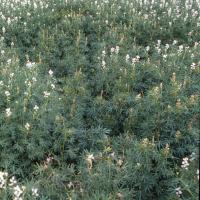Diagnosing cucumber mosaic virus in narrow-leafed lupins
Cucumber mosaic virus (CMV) is a seed- and aphid-borne virus that infects narrow-leafed lupins. Wheatbelt regions most at risk are the high rainfall zones of the northern and central agricultural region and the south coastal region.
What to look for
- Seed-infected plants are pale, stunted and distributed evenly throughout the paddock.
- Plants infected by aphid transmission have pale bunched young growth. They are often affected first and most severely on paddock edges or other bare areas, particularly on the windward side and adjacent to legume pastures. Patches are also common with infection spreading out from the centre.
Paddock
- Leaves appear to be bunched and curled-down with a faint mosaic pattern.
- Plants that grow from infected seed are severely stunted with all leaves showing symptoms.
- Healthy plants that become infected during the growing season have pale, bunched young leaves with faint mosaic patterns while older leaves formed prior to infection appear normal. As growth continues, all new leaves show symptoms and the infected plants become stunted.
- With late infections symptoms are restricted to tip leaves.
- The earlier a plant becomes infected, the fewer the pods set, the smaller the size of seed produced and the smaller the yield.
Plant
What else could it be
| Condition | Similarities | Differences |
|---|---|---|
| Diagnosing boron deficiency in narrow-leafed lupins | Stunted plants with small new leaves | Affected plants limited to sandy acidic parts of the paddock |
| Diagnosing bean yellow mosaic virus - non necrotic in narrow-leafed lupins | Stunted plants with small new leaves | New leaves are upright and fleshy rather than umbrella-shaped. Not seed transmitted. |
Where did it come from?

Contaminated seed

Insect vector
Sources of virus
- Sowing infected seed produces infected seedlings scattered at random within the crop. Aphids pick up the virus from the infected plants and spread it to nearby healthy plants. When infection incidence reaches 100 per cent, the maximum possible seed transmission rate to seedlings varies with lupin variety.
- In the wheatbelt, although infected lupin seed is the only CMV source of consequence for lupin crops, other legume hosts can become infected, including clovers, chickpea, faba bean, lentil and field pea. Weeds that sometimes become infected include capeweed, stagger weed and fumitory, but the virus is not seed-borne in these species so infection is lost over summer.
Aphid vectors
- CMV is spread by many aphid species, including green peach, blue green, and cowpea aphids that colonise lupins as well as migrants of common non-lupin colonising species, especially oat, and turnip aphids.
- CMV is transmitted non-persistently: an aphid picks it up within one to two seconds while probing an infected plant, but the virus is then lost again when the aphid probes one or two healthy plants
Contributing factors
- Yield losses can reach 60 per cent when all plants in a crop become infected. Losses from CMV infection are greatest when seed with >1% infection is sown, aphids arrive early and widespread plant infection occurs.
- The outcome of sowing seed infected with different levels of CMV varies greatly from year to year and site to site.
- Sowing seed with a high level of infection, which develops many in-crop sources, together with an early arrival of aphids initiates substantial early epidemics resulting in high disease incidence, reduced yield and increased infection in harvested seed.
- By contrast, a dry start to the growing season and sowing seed with a high level of infection results in minimal yield loss and reduction in infection levels in harvested seed. The aphids arrive much later, resulting in a much reduced CMV spread.
Management strategies

Clean seed

Stubble management

Grass weed control
- An integrated disease management approach is needed to control CMV in lupin crops, one which uses a range of control measures.
- Sowing healthy lupin seed is the most important measure. In low risk areas, seed with < 0.5% infection can be sown without undue risk of yield loss. Seed infection of < 0.1% (a zero result from a 1000 seed test) is recommended for grain crops in high risk areas, and for seed certification crops in any rainfall zone.
- Sow early at high seeding rates using narrow row spacing to promote early crop canopy coverage. This deters aphids from landing and shades over the seed-infected and early infected plants, denying aphids access to them.
- Direct drill into retained stubble. Groundcover reduces aphid landing rates before a crop canopy develops, especially with wide row spacing.
- Isolate from neighbouring lupin crops.
- Maximise weed control. This reduces spread of CMV from lupins to weeds and then from weeds back to lupins.
- Note: Insecticides applied to crops are ineffective at controlling CMV
How can it be monitored?
- Test seed for disease infection.
Where to go for expert help
Page last updated: Thursday, 5 February 2015 - 9:51am





